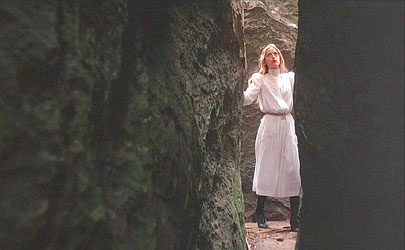
While I stumbled in trying to explain my sensibility a class ago, here’s the thing: I’m an auteurist. I tend to think the artistic influence of direction is pervasive enough to affect anything in a film I might find potentially rewarding. Rather than dwell on Picnic at Hanging Rock, I’ll do an auteurist rundown of last week’s film, Fred Schepisi’s The Devil’s Playground.
On the basis of this movie, Schepisi doesn’t strike me as totally adverse to subtlety: there’s some low-key stuff here, performance-wise. And yet it fails to coalesce into anything satisfying for me. While quiet, the film is in its own way simple, direct, and not especially wise about the way people actually behave. The love interest subplot, for example, seems more about evoking pleasant emotions than observing characters. In theory, I liked that the protagonist Tom’s rather public bedwetting problem and social acceptance coexist, complicating the stigma of the former, but again I found Schepisi’s direction of social ridicule not especially graceful or convincing.
The implied homoeroticism in the film embodies Schepisi’s assets and faults as a director. In an early scene, an official of the school scrutinizes a nude boy in a locker room, all the while admonishing the boys for taking a glance or two. The actor shoots for the tone any idiot could extract from the speech: rigid, strict, serious. On the one hand, the delivery allows for some openness to interpretation: the official’s convictions could be genuine, and he could be masking some personal demons by projecting them on students. And yet the flatness of the actor’s delivery seems to make this mystery unearned, not fully developed. A later scene featuring a priest who seems a mite too curious about Tom’s sexuality sticks to a similarly repetitive pattern of performance: Tom obviously displays a mixture of discomfort and derision, and the priest doesn’t sway from forced gentleness. Surely teachers run the gamut from stern to sentimental, and at least Schepisi recognizes this, but he doesn’t seem interested in the variety of behavior a single man might exhibit, or in his ability to make his inclinations mysterious.
An obvious literary analogue to this film is James Joyce’s A Portrait of the Artist as a Young Man, much of which takes place at a Catholic school for boys, and tracks its protagonist’s burgeoning sexuality, attempts to socially integrate, and private anguish. The gestalt of Joyce’s novel, it seems to me, is that Stephen Dedalus never quite experiences youth in the manner he's instructed to, and learns a lot from that slight dissonance from the rest of the world; distance lends perspective. In contrast, Tom seems perfectly fulfilled at his heights. He’s living a dream, a life too drenched in sentiment to offer truth.
- Sky Hirschkron






